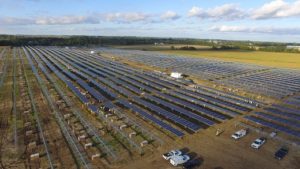11.01.2016
Utility-Scale Solar: A Bright Future
 If you haven’t noticed, there is a revolution taking place, and no, I’m not talking about the 2016 presidential race – that’s a whole different situation. What I am referring to is the explosion of new utility-scale photovoltaic (PV) farms.
If you haven’t noticed, there is a revolution taking place, and no, I’m not talking about the 2016 presidential race – that’s a whole different situation. What I am referring to is the explosion of new utility-scale photovoltaic (PV) farms.
When I say “utility-scale,” I’m not talking about a few solar panels on a home; I’m talking about hundreds of acres of solar panels mounted to state-of-the-art tracking systems. These large PV fields have the capability of generating 100, 200 or even 300 megawatts (MW) of power – enough to serve 17,000 – 41,000 homes. To give you a comparison, a typical coal fired power plant generates about 500 MW of power.
According to the GTM Research / SEIA U.S. Solar Market Insight Q2 2016 report, the U.S. installed 1,665 MW of solar PV in the first quarter of 2016, which is both an increase of 24% over the first quarter of 2015, and the largest non-fourth quarter of PV installation in the history of the U.S. solar industry. In the first quarter of 2016, solar accounted for 64% of all new electric generating capacity brought on line in the U.S. GTM research forecasts that 14.5GW of new PV installations will come on line in 2016. This up 94% over 2015!
It is anticipated that U.S. PV will become a 20GW annual market by 2021. So why is there so much growth taking place? There are really three main factors: the Federal Solar Investment Tax Credit, State Renewable Energy Standards, and Technological Advancements.
ITC Extension:
The Federal Solar Investment Tax Credit, also referred to as the ITC, is a dollar-for-dollar reduction in the invested party’s income taxes. The business that installs, develops, and/or finances the project is eligible to claim the tax credit. This program was extended by Congress in December of 2015, and is considered to be one of the most important policy developments for the U.S. Solar market in more than a decade. A 30% ITC will be available to any project that commences construction through 2019. In 2020, the ITC will be 26%; in 2021, it will be 22%; and after 2023, the commercial and utility credit will then drop to 10% indefinitely.
In addition to the ITC, the government allows the system to be depreciated to zero (full write-off) using the five-year Modified Accelerated Capital Recovery System. Between the tax credit and the accelerated depreciation, the return on investment for a large solar project can go from 10 years down to two or three years. This is a huge attraction to investors and developers.
Renewable Energy Standards:
Twenty-five states have a renewable energy portfolio standard (RES), and eight states have renewable energy portfolio goals. What this means is that the utility companies are required to purchase a minimum amount of renewable energy to achieve the portfolio limits (renewable portfolio standards can be found on the clean energy database at www.dsireusa.org).
In a number of states, there are escalation factors that increase the minimums each year. By way of example, a state could have a 2% increase in renewables over a 10 year period to meet the ultimate goal of 20% renewables. Types of power that meet the renewable energy standards could be wind, solar, hydro and nuclear. There are 18 states that have provided “carve-out” provisions in their renewable energy standards. These specific carve-outs identify the percentage of power that needs to be generated via solar. Minnesota, for example, has a 1.5% carve-out for solar for public utilities to meet by 2020.
Technology Advances / Cost:
According to the U.S. Department of Energy 2016 clean technology update, over the past eight years, the cost of utility-scale PV has fallen by more than 64%. This cost reduction is a combination of product innovations and increased manufacturing and lower installation cost.
Similar to other technologies such as smart phones, electronic tablets, e-readers or flat screen TVs that have come along over the past 10 years, the first versions are usually the most expense. As demand goes up, production goes up, production efficiencies are shared, waste is eliminated, and the result is a decrease in cost. The other side of the equation is the installed cost. As more contractors enter the market and more installers are trained on installation techniques, waste is eliminated from the process and the installation costs are reduced.
The solar industry is here to stay, and according to the U.S. Department of Energy, there is enough solar energy and land area available in this country for utility-scale PV to generate 10 times the energy needed to power the entire nation.
The three advances that I reviewed here are the first steps in economically capturing and converting solar into useful energy. It doesn’t create pollution, it is quiet, there are no environmental risks, it is available everywhere, and it is the cleanest and most abundant resource that we have. Let the journey begin!
If you enjoyed this blog article, please subscribe to stay up to date on the latest industry news from our experts at Faith Technologies.



